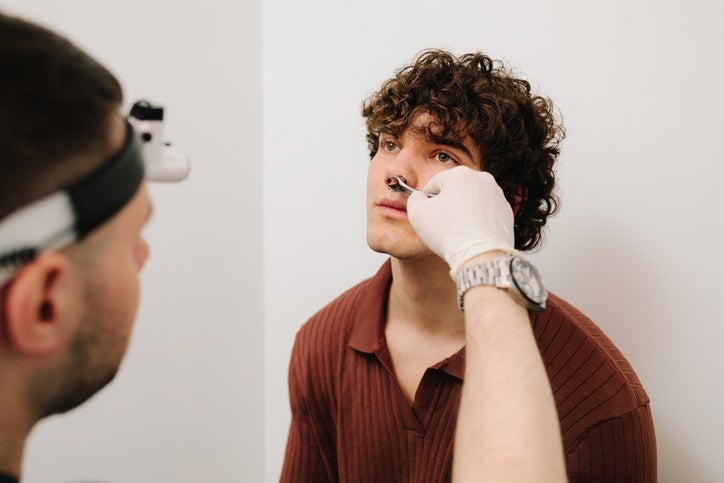The Role of ENT Specialists in Diagnosing the Need for Sinus Surgery
Diagnosing the Need for Sinus Surgery
Many sinus conditions can be treated successfully without surgery, and ENT specialists have many treatment options at their disposal. However, if a sinus problem has not responded to other treatment methods, surgery may be an effective alternative. When you have a persistent sinus issue, it’s important to schedule a consultation with an experienced, knowledgeable ENT specialist, to properly diagnose your condition and determine whether surgery is an appropriate option.

What is Sinus Disease?
The sinuses are air-filled cavities in the bones of the face and skull, and there are four primary pairs of sinuses. The maxillary, frontal, ethmoid, and sphenoid sinuses are each important for respiratory function, and they are lined with a mucus membrane, like the membrane that lines the nasal cavity. Your sinuses perform functions like humidifying and warming inhaled air, reducing the weight of the skull, and enhancing the resonance of your voice. The sinuses are connected to the nasal cavity, and this allows mucus to drain. When the openings between the sinuses and nasal cavity are blocked, the result can be sinusitis and other types of sinus disease. The sinuses become inflamed and swollen, and infections and nasal polyps can contribute to chronic sinusitis. Fortunately, in many cases, ENT specialists can perform minimally invasive surgeries to alleviate these conditions.
When is Sinus Surgery Needed?
An ear nose and throat doctor will take a comprehensive approach to diagnosing sinus conditions. If you are having symptoms, your doctor will take down your medical history, perform a clinical examination, and use advanced diagnostic tools, to get a complete picture of what is going on in your sinuses. A nasal endoscopy may be part of your physical examination, so that the doctor can visualize the nasal passage and sinuses, and advanced imaging techniques like CT scans or an MRI may be used for a more detailed view of the sinus anatomy. The doctor needs to see inside the sinuses, to detect inflammation, polyps, or structural abnormalities. Allergy testing may also be conducted, to determine if the sinus problems involve allergic rhinitis. Once an accurate diagnosis is made, your ENT specialist will recommend appropriate treatment options tailored to your condition
Types of Sinus Surgery
What do you need to qualify for sinus surgery? Conditions like nasal polyps or a deviated septum may require surgery, and sometimes bone must be removed to open sinus pathways. Do you need surgery for a sinus infection? In some cases, surgery must be performed to remove severely infected, damaged tissue. The surgery required depends on the condition diagnosed, but types of sinus surgery include:
- Functional Endoscopic Sinus Surgery (FESS), is performed using an endoscope. In this minimally invasive procedure, a thin, flexible tube with a camera and light attached is used to visualize the nasal passages and sinuses. This allows the doctor to work through the nostrils to treat sinus issues, without making an external incision. FESS is often used to treat sinus blockages, chronic sinusitis, and nasal polyps.
- Balloon Sinuplasty is another minimally invasive alternative to traditional surgery. In this procedure, a balloon catheter is inserted into a blocked sinus cavity. By inflating the balloon, the doctor can widen the sinus opening, so that drainage and ventilation can be improved. This procedure is used for chronic sinusitis and recurrent sinus infections.
- Septoplasty is used to correct a deviated septum. The septum is a thin wall of cartilage and bone within the nasal cavity, and it is the element that divides the two nostrils. When the septum is deviated, airflow may be obstructed, and this can lead to congestion, sinus infections, and breathing difficulties. Septoplasty is surgery to straighten the septum and improve nasal airflow.
- Turbinate reduction reduces the size of the turbinates, small structures inside the nasal passages. The function of turbinates is to humidify and filter the air you breathe, but when they become enlarged, turbinates can block airflow. There are different methods of turbinate reduction, including radiofrequency ablation, laser therapy, or surgical excision.
- Ethmoidectomy removes diseased or obstructive tissue from the ethmoid sinuses. These sinus cavities are located behind the bridge of the nose, between the eyes. When tissue in the ethmoid sinuses becomes damaged or severely infected, it needs to be removed, to treat chronic sinusitis and other sinus-related condition. This procedure is also used to remove nasal polyps.
- Maxillary antrostomy creates a surgical opening in the maxillary sinus. The maxillary sinus is the largest of the paranasal sinuses, and it is located below the eyes. When an opening is created in this cavity, it allows for better drainage and ventilation, which can reduce the risk of infection and other sinus issues.
Benefits of Early Diagnosis and Treatment
As with many health issues, sinus conditions are best addressed early, for improved outcomes. When your sinuses aren’t functioning properly, it can hurt the overall health of your body, because the sinuses regulate airflow, filter the air we breathe, remove contaminants, and prevent infection. Further, a sinus infection can sometimes lead to other illnesses, like an upper respiratory infection, bronchitis, or even pneumonia. Being proactive about your sinus health is a good way to keep your whole body healthy.
Sinus Surgery Recovery and Post-Surgery Care
After you’ve had sinus surgery, you will need to follow the instructions provided by your ENT specialist. You will need to adhere to restrictions on your activity, take medications as directed, and irrigate your nasal passages as directed. Regular follow-up visits will also be provided to monitor healing and address any additional concerns promptly. By following all postoperative instructions precisely, you will be promoting a smoother recovery and the best possible outcome.
Oasis ENT Can Address Your Sinus Issues
If you live in the Surprise, Arizona area and have sinus issues, trust the patient-focused specialists at Oasis Ear, Nose, & Throat. At Oasis ENT, we are committed to helping our patients overcome a variety of ear, nose, and throat problems, using a wide variety of sinus treatments, including sinus surgery. We embrace emerging, yet proven perspectives, patient-focused therapies, and advanced technology, to address sinus problems and allergies. Our highly skilled team has the knowledge and experience to identify the most suitable solution for each patient, and our goal is to help patients breathe better, without sinus issues. We also want our patients to understand that there are treatments for their conditions, and they don’t have to settle for less. Contact us to schedule an appointment, or to learn how our boutique healthcare approach is designed to support patient-centered care and help improve symptoms for many individuals. Results vary based on individual health needs.
The information provided in this article is for informational and educational purposes only and does not constitute medical advice. It is not intended to diagnose, treat, cure, or prevent any disease or medical condition. Always seek the guidance of your physician or other qualified healthcare provider with any questions you may have regarding a medical condition or treatment.
Results may vary: Treatment outcomes and health experiences may differ based on individual medical history, condition severity, and response to care.
Emergency Notice: If you are experiencing a medical emergency, call 911 or seek immediate medical attention.


